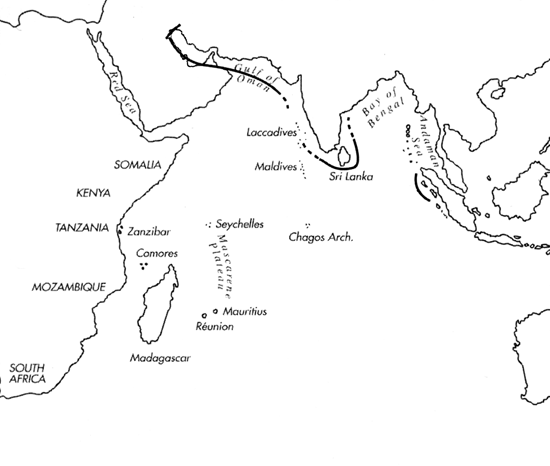
Skip Navigation Links
View access keys for this site.

Range: Persian Gulf, Gulf of Oman and Pakistan, Sri Lanka and S.E. India, and N. W. Sumatra.
Description: Moderately small to medium-sized, moderately light to moderately solid. Last whorl narrowly conical or conical; outline slightly convex adapically, usually straight below; left side may be concave toward base. Shoulder angulate to sharply angulate. Spire of moderate height or high, outline concave. Larval shell of 1.75-2.25 whorls, maximum diameter 0.8-0.9 mm. Subadult specimens (L 19-28 mm) with 5.75-7.75 postnuclear whorls, adult specimens (L33-38 mm) with 9-9.5. First 4-7 tuberculate. Teleoconch sutural ramps slightly concave, with closely spaced axial threads and 1-2 spiral grooves; latest ramps may also bear 1-2 finer spiral grooves and many spiral striae. Last whorl with spiral grooves separated by ribbons on basal third to two-thirds, sometimes to shoulder.
| Shell Morphometry | ||
|---|---|---|
| L | 28-48 mm | |
| RW | 0.06-0.16 g/mm | |
| (L 28-43 mm) | ||
| RD | 0.47-0.60 | |
| PMD | 0.83-0.93 | |
| RSH | 0.17-0.26 | |
Ground colour cream to pale violet or grey. Last whorl with orange to brown axial clouds and streaks or flames, generally fusing into 3 spiral bands, within basal third, near centre and below shoulder. Numerous spiral rows of similarly coloured dots extend from base to shoulder; these vary in number and arrangement. Base pinkish to orangish red. Larval whorls white. Teleoconch sutural ramps with brown axial streaks and blotches, partially reduced to spots along outer margins. Aperture white marginally, violet within; basal portion often orange.
Periostracum brownish grey, thin, translucent, smooth.
Habitat and Habits: In 15-100 m; in shallow water, on coral sand (Persian Gulf). Egg capsules of 11-14 x 6.5-7.5 mm deposited in single rows; each contains 50-75 eggs 500-650 ┬Ám in diameter (Thorson, 1940, as "C. planiliratus Swb. var. acutangulus Chem."; see Moolenbeek & Coomans, 1986). Number and size of eggs suggest benthic development (Perron & Kohn, 1985, as "C. inscriptus"), while Thorson reported the hatchling to have planktonic stage
Discussion: C. dictator may be mistaken for C. lentiginosus. The latter species differs in the more convex, broader last whorl (RD 0.60-0.69) and usually has fewer tuberculate spire whorls, a coarser colour pattern and simpler colouration of the aperture. For comparison with C. milesi, C. traversianus and C. stocki, see DISCUSSIONS of these species.

C. dictator range map
This section contains verbatim reproductions of the accounts of 316 species of Conus from the Indo-Pacific region, from Manual of the Living Conidae, by R÷ckel, Korn and Kohn (1995). They are reproduced with the kind permission of the present publisher, Conchbooks.
All plates and figures referred to in the text are also in R÷ckel, Korn & Kohn, 1995. Manual of the Living Conidae Vol. 1: Indo-Pacific Region.
The range maps have been modified so that each species account has it own map, rather than one map that showed the ranges of several species in the original work. This was necessary because each species account is on a separate page on the website and not confined to the order of accounts in the book.
Return to framed version (returns to search page)